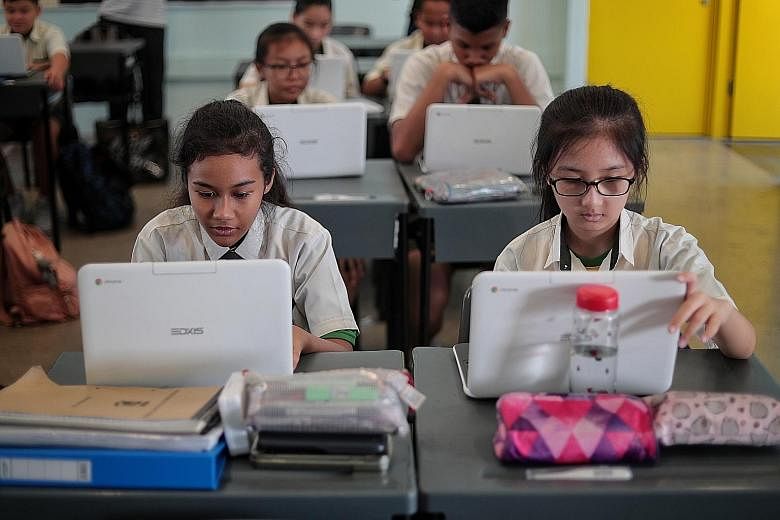All 280 Secondary 2 students at Orchid Park Secondary School have had a Chromebook since last year, as part of a pilot programme using personal learning devices.
Over the next four years, more students across schools will similarly have a device in hand, on which they can access the Singapore Student Learning Space (SLS) - an online learning platform with educational tools and resources - in class and at home.
It will start with Secondary 1 students, but by 2028, every secondary school student will have his own device, Education Minister Ong Ye Kung said yesterday during the debate on the ministry's budget.
This is part of a national digital literacy programme the Ministry of Education (MOE) is rolling out.
Bulk tender will be used to lower the price to "probably a few hundred dollars", Mr Ong said, and all students will get an Edusave top-up of $200 to support the purchase. Students from lower-income households will get further subsidies so that their out-of-pocket cost is zero.
Teachers can assign work through SLS and monitor students' progress in real time. They can also see which questions students are struggling with and quickly address any misconceptions.
During a media visit to Orchid Park Secondary last Wednesday, The Straits Times observed a mathematics teacher using a "heat map" to show students' answers to various questions.
The teacher could see a list of students' names and, next to them, a row of boxes that changed colour in real time. Green and red indicate a right and wrong answer respectively, while yellow could indicate a student was unsure. This clued the teacher in to which students needed help.
More schools have adopted this online learning platform since it was rolled out in 2018 by MOE.
Besides such in-class work, teachers can use SLS to curate resources such as YouTube videos.
Mr Aaron Loh, MOE's divisional director of educational technology, told ST that resources are continually developed and updated.
There is also an SLS Community Gallery where teachers can share lessons with the teaching fraternity, "creating a rich pool of teacher-initiated resources that their peers can use and learn from", said Mr Loh.
Orchid Park Secondary's head of information and communications technology Tan Yaw Jin, who is also a Chinese language teacher, said students have become more expressive in their views when sharing opinions online.
An option to post anonymously "makes them more open to share their views without worrying about embarrassing themselves or sounding superficial".
Teachers can still use the answers for class discussions and get students to speak up to build their confidence.
The school's principal, Mr Shawal Hussin, said: "(With the personal devices), students understand topics better through visual and audio aids. At any time, they can revise their work and are not restricted by the old ways of learning."
There are also ways to control usage and screen time, such as blocking gaming apps or programming the devices to switch off after midnight.
Mr Shawal said the school has not stopped students from accessing social media platforms. Cyber wellness programmes teach them to navigate such spaces responsibly, he said. "There's no point bubble-wrapping them... We can teach them how to use (social media) properly and inculcate good values in them."
Sec 2 student Vincent Tse, 13, said he frequently uses his Chromebook to take notes in class as it is quicker than writing.
"It's a privilege to have such resources... it makes class more interesting so we can stay focused."
MOE will also expose more children to computational thinking. Starting this year, all primary schools will offer a 10-hour Code for Fun enrichment programme for upper primary pupils.
From next year, more secondary schools - 30, up from 22 - and junior colleges - 10, up from eight - will also offer O-and A-Level computing to boost the computing talent pipeline.
A revised lower secondary science syllabus will be rolled out next year to give students a better understanding of emerging technologies such as artificial intelligence.
The institutes of higher learning also aim to build a foundation in basic digital competencies for its students.
They will expose students to skills such as quantitative reasoning through new or enhanced modules.
Students in fields that require more advanced digital skills, such as the finance and cyber security sectors, will be able to pursue such competencies at higher levels.


